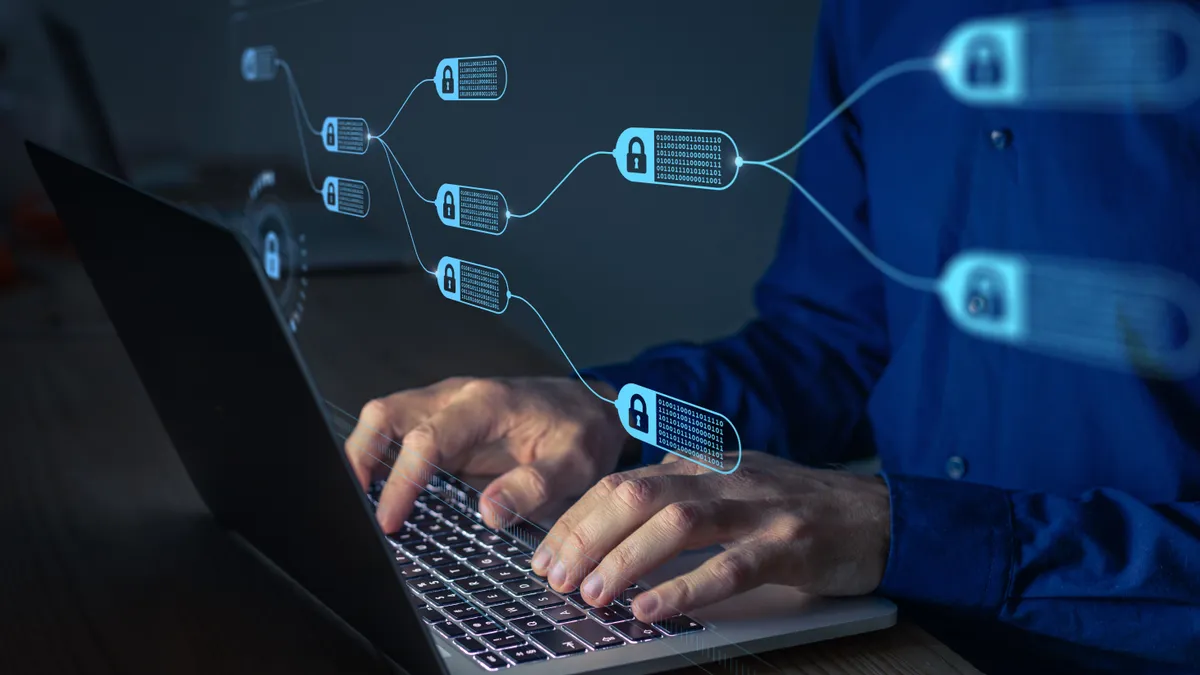Editor's note: This article is the latest in a series that looks into the ways supply chains, warehouses and manufacturing facilities are investing in technology. Here's the previous story.
While blockchain is often talked about in relation to cryptocurrency (and grabs headlines for it), it’s already being used in supply chains to create greater visibility and transparency.
"If you think of supply chain today, and the volume of paper and faxes and email and data exchanges and phone calls that actually support the process, it seems pretty obvious that if you could get enough people to streamline those things using a common system and a common application, you could get a whole lot of value out of that process," said Scott Buchholz, emerging technology research managing director at Deloitte.
In "Innovation Driven Resilience," the 2021 MHI Annual Industry Report, MHI and Deloitte surveyed more than 1,000 supply chain professionals worldwide about innovation investments in the supply chain. They found that 10% of companies surveyed plan to invest in blockchain and distributed ledger technologies in the next three years. They also found that 12% have blockchain in use today, and 41% predict it will be in use within the next five years.
While the usefulness is already being seen in areas like grocery and luxury goods, blockchain — and that level of true transparency — is not an easy sell. As the technology grows, though, it may change the definition of visibility in supply chains altogether.
Blockchain boosts traceability
Blockchain gained footing in grocery, where knowing the source of a product can be a matter of life or death. The technology is allowing retailers to quickly pinpoint the source of outbreaks of pathogens like E. coli.
Walmart, which uses IBM’s blockchain platform, says it can trace the source of mangos in one of their stores in 2.2 seconds. Before, they would need six days. Not only does blockchain help a retailer know quickly where the outbreak started, but it also means that they know which food items need to be destroyed, and what can stay on the shelves.
While that’s important for consumer safety, if grocers allow consumers to access blockchain via a QR code, it can also give grocery stores a marketing leg up.
"You see coffee beans on the self and via a QR code you can see these coffee beans came from this location during this kind of activity. It gives you a story line," said David Furlonger, vice president and Gartner Fellow in Gartner's CEO and Digital Business Leaders research group.
Blockchain has also found footing in luxury items, especially those where customers seek authenticity.
Hong Kong-based jeweler Chow Tai Fook sells diamonds certified by the Gemological Institute of America and that meet the requirements of the United Nations’ Kimberly Process, which means they’re ethically sourced. They use blockchain to digitize their diamonds’ certifications. "That’s how we protect our customers," Jade Tin Hei Lee, general manager of business analytics and technology applications at Chow Tai Fook Jewellery Group, told Deloitte for their "Tech Trends 2022" report. "With blockchain, they have full transparency into the journey and the quality of their diamond."
Who governs a decentralized system?
For blockchain to work across the supply chain, everyone involved must add information about products to it, and make that information accessible to everyone else. "Not all organizations feel comfortable sharing data with others," said Arthur Carvalho, assistant professor of information systems and analytics at the Miami University Farmer School of Business.
Blockchain also faces the challenge of governance, he added, and must work through various basic questions. Who is going to own the blockchain system? Who will pay for it? And when the blockchain owner wants to make an upgrade, how does that work and how can that be coordinated across every single vendor in the supply chain?
A company like Walmart can implement blockchain — like it did for 2019 for suppliers of fresh leafy greens — because of their dominance in the market. A vendor could say no, but then they could lose Walmart as a customer. "Walmart has so much power and leverage and influence that they can go down to farmers and packers and say please adopt my system," said Carvalho, and also provide software and subsidies to adopt it.
Successful use cases can build confidence in the technology, and lead to its adoption in other areas, said Buchholz.
"There will be waves of adoption that start with things like high value jewelry or high spoilage items like food, and work their way down as costs come down and standards get adopted, he said. "If you look at the history of adoption, it starts somewhere and grows from there."
This story was first published in our Operations Weekly newsletter. Sign up here.













